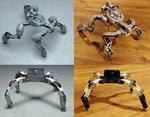Other

“Ubiquitous sensors seem almost synonymous with the internet of things (IoT), but some Carnegie Mellon University researchers say ubiquitous sensing — with a single, general purpose sensor for each room — may be better. The plug-in sensor package they have developed monitors …

“One of the most popular passwords in 2016 was “qwertyuiop,” even though most password meters will tell you how weak that is. The problem is no existing meters offer any good advice to make it better—until now. Researchers from …

“Touch sensing is most common on small, flat surfaces such as smartphone or tablet screens. Researchers at Carnegie Mellon University, however, turn surfaces of a wide variety of shapes and sizes into touchpads using tools as simple as a can …

“A version of Carnegie Mellon University’s Libratus, which in January became the first artificial intelligence to defeat top poker pros at Heads-Up, No-Limit Texas Hold’em, will play six top Chinese players for a $290,000 winner-take-all purse. The …

“Spotting a face in a crowd, or recognizing any small or distant object within a large image, is a major challenge for computer vision systems. The trick to finding tiny objects, say researchers at Carnegie Mellon University, is to look …

“Libratus, an artificial intelligence developed by Carnegie Mellon University, made history by defeating four of the world’s best professional poker players in a marathon 20-day poker competition, called “Brains Vs. Artificial Intelligence: Upping the Ante” at Rivers Casino in …

“A revolutionary and emerging class of energy-harvesting computer systems require neither a battery nor a power outlet to operate, instead operating by harvesting energy from their environment. While radio waves, solar energy, heat, and vibrations have the ability to power …
“Using a new imaging technique, researchers have developed a way to “fingerprint” the human brain, confirming what scientists have always thought to be true: the structural connections in the brain are unique to each individual person. The Carnegie Mellon University-led …

“Clutter is a special challenge for robots, but new Carnegie Mellon University software is helping robots cope, whether they’re beating a path across the moon or grabbing a milk jug from the back of the refrigerator. The software not …

“Ever since the advent of smartwatches, technologists have been looking to expand interactions beyond the confines of the small watch face. A new wearable technology developed at Carnegie Mellon University suggests turning the entire lower arm into a touchpad. Called …

“Even a novice can design and build a customized walking robot using a 3-D printer and off-the-shelf servo motors with the help of a new design tool developed by Disney Research and Carnegie Mellon University. The user can specify the …
